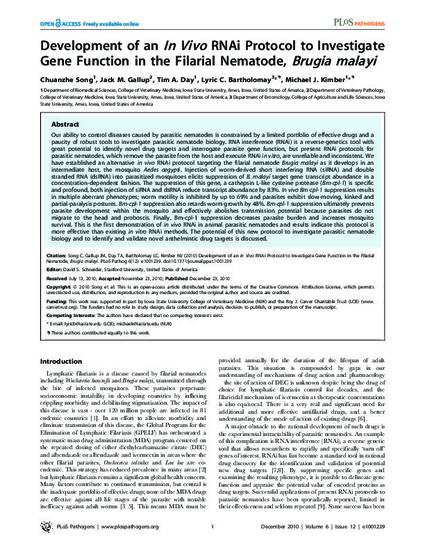
Our ability to control diseases caused by parasitic nematodes is constrained by a limited portfolio of effective drugs and a paucity of robust tools to investigate parasitic nematode biology. RNA interference (RNAi) is a reverse-genetics tool with great potential to identify novel drug targets and interrogate parasite gene function, but present RNAi protocols for parasitic nematodes, which remove the parasite from the host and execute RNAi in vitro, are unreliable and inconsistent. We have established an alternative in vivo RNAi protocol targeting the filarial nematode Brugia malayi as it develops in an intermediate host, the mosquito Aedes aegypti. Injection of worm-derived short interfering RNA (siRNA) and double stranded RNA (dsRNA) into parasitized mosquitoes elicits suppression of B. malayi target gene transcript abundance in a concentration-dependent fashion. The suppression of this gene, a cathepsin L-like cysteine protease (Bm-cpl-1) is specific and profound, both injection of siRNA and dsRNA reduce transcript abundance by 83%. In vivo Bm-cpl-1 suppression results in multiple aberrant phenotypes; worm motility is inhibited by up to 69% and parasites exhibit slow-moving, kinked and partial-paralysis postures. Bm-cpl-1 suppression also retards worm growth by 48%. Bm-cpl-1 suppression ultimately prevents parasite development within the mosquito and effectively abolishes transmission potential because parasites do not migrate to the head and proboscis. Finally, Bm-cpl-1 suppression decreases parasite burden and increases mosquito survival. This is the first demonstration of in vivo RNAi in animal parasitic nematodes and results indicate this protocol is more effective than existing in vitro RNAi methods. The potential of this new protocol to investigate parasitic nematode biology and to identify and validate novel anthelmintic drug targets is discussed.
Available at: http://works.bepress.com/michael-kimber/2/

This article is from PLoS Pathogens 6 (2010): e1001239, doi:10.1371/journal.ppat.1001239. Posted with permission.